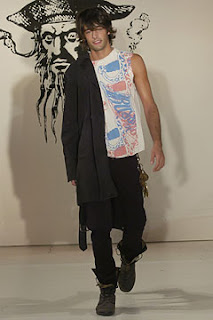Beatnik
A person who participated in a social movement of the 1950s and early 1960s which stressed artistic self-expression and the rejection of the mores of conventional society. Usually a young and artistic person who rejects the mores of conventional society.
Beatniks on the bank of the Seine in Paris, France from Life magazine 1963
Lauren Conrad - Fall 2008 RTW
Gianni Versace - Fall 2007 RTW
Disco
Disco is a genre of dance music that had its roots in clubs that catered to African American, psychedelic and other communities in New York City and Philadelphia during the late 1960s and early 1970s. Disco was a reaction primarily among New York City gays against both the domination of rock music and the demonetization of dance music by the counterculture during this period.
"Disco Fashion" by Chet King
Chloé - Fall 2000 RTW
Diane von Furstenberg - Spring 2001 RTW
Hip Hop
Hip-hop fashion is a distinctive style of dress originating with African-American youth on the scene of Los Angeles, New York, Chicago, Philadelphia, The San Francisco Bay Area, Detroit, Atlanta and Miami among others. Each city contributed various elements to its overall style seen worldwide today. Hip hop fashion complements the expressions and attitudes of hip hop culture in general. Hip hop fashion has changed significantly during its history, and today it is a prominent part of popular fashion as a whole across the world and for all ethnicities.
Jay Z
William Rast - Spring 2009 RTW
Kanye West Clothing Line - 2009
Hippie
The hippie subculture was originally a youth movement that began in the United States during the early 1960s and spread around the world. The word hippie derives from hipster, and was initially used to describe beatniks who had moved into San Francisco's Haight-Ashbury district. These people inherited the countercultural values of the Beat Generation, created their own communities, listened to psychedelic rock, embraced the sexual revolution, and used drugs such as marijuana and LSD to explore alternative states of consciousness.
Woodstock 1969
Dries Van Noten - spring 2008 RTW
Gucci - 2007 Cruise Wear
Mod
Mod is a subculture that originated in London, England in the late 1950s and peaked in the early to mid 1960s. Significant elements of the mod subculture include: fashion, pop music, including African American soul, Jamaican ska, and British beat music and R&B; and Italian motor scooters. The original mod scene was also associated with amphetamine-fuelled all-night dancing at clubs.
Twiggy - 1968
Saint Augustine Academy - Spring/Summer 2009/2010
Paco Rabanne - Spring 2006
Punk
The punk subculture is a subculture based around punk rock. It includes music, ideologies, fashion, visual art, dance, literature and film. The punk scene is composed of an assortment of smaller factions that distinguish themselves from one another through unique variations. Several of these factions have developed out of punk to become subcultures in their own right.
SidVicious - Paris1978
Buddhist Punk - Spring 2005 RTW
Mulberry - 2009 RTW
Teddy Boys
Wearing oversized draped jackets and quiffed hair, they emulate the Teddy boy fashion of the 1950s Breaking from convention, teenage youths embraced the casual and affordable American-influenced style and culture.
Boys smoking, Portland Road - 1956
Jens Laugesen - Fall 2008 RTW
Topshop Unique - spring 2009 RTW
Zoot Suit
The zoot suit, popularized by African-American and Mexican-American teens during the late 1930s and early 1940s, didn’t look like your average workday attire. It had broad shoulders, a tapered waist, and baggy pants that ended in neat, pegged cuffs. The excess fabric and tailoring made it a defiant luxury item – a sign that the wearer wasn’t affected by Depression-era poverty or World War II fabric rationing.
Zoot suit - 1942
John Galliano - Spring 2002 RTW
Dior Homme - Fall 2008 Men’s Collection
Leggings
Lindsay Lohan - Hollywood
Balenciaga - Spring 2007 RTW
Elise Overland - Fall 2009 RTW
Over The Knee Boots
"Gossip Girl" - 2009
Stella McCartney - Fall 2005 RTW
Givenchy - Spring 2009

















































